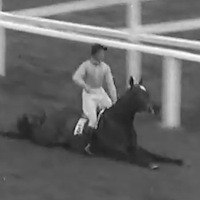First Black Space Walk (February 9, 1995)

Michael Jackson may have developed the moon walk, but Dr. Bernard Harris was the first African-American walk in space. The Space Race began in the late ‘50’s as Russia and the United States began competing to be the first in space, the first to orbit the Earth, the first to the moon, etc. Russia sent Yuri Gagarin into space in 1961 and won the “first man in space” and the “first man to orbit the Earth” titles. John Glenn would have to settle for the title of first American to orbit the Earth. Apollo 11 saw the first three men on the moon—Neil Armstrong, Buzz Aldrin, and Michael Collins. Collins would orbit the moon while Armstrong and Aldrin actually set food on the moon (1969) 1 Valentina Vladimirovna Tereshkova, in 1963, became the first woman in space2—of course, Sally Ride, in 1982, would be the first American woman in space. But, Dr. Bernard Harris has a unique distinction. On February 9, 1995, Dr. Harris became the first black man to walk in space. 3
Harris, according to his Wikipedia entry, received a medical degree in 1982 and completed his residency at Mayo Clinic. During a fellowship program with NASA, he began work on musculoskeletal research—something that would come into great use after completing his fellowship.
Once he left Ames, he went to the Johnson Space Center and continued his research, testing the effects of extended space flights on the human body and developing methods to make it easier for the body to endure the exposure to forces. His research paid off and in August of 1991, he was assigned as a specialist for the Space Station missions. In April of 1993, Harris became the first black man in space. Two years later, he became the Payload Commander for the joint Russian-American Space Station missions and on February 9, he became the first black man to walk in space. In an interview with CNN, he reflected about the historic impact that his space walk had on the world and on individuals. "’To be the first was great, it really was,’ he said. ‘But to me, it signifies that there would be many more behind me. … If you don't know where you are and where you came from, you'll never know where you are going.’”
Harris set about to accomplish his dream. He’d wanted to be an astronaut from the time he was eight years old. After he left NASA in 1996, he went on to start The Harris Foundation in Houston, TX. According to their homepage, “The Harris Foundation was created to enable youth to develop and achieve their full potential through the support of social, recreational and educational programs for grades K thru 12.”4 Visit their website for more information about how you can help a child dare to dream and expand their horizons.
For more information, please visit the following links:
Wikipedia
CNN’s Article
Harris’ Biography at The Harris Foundation’s site
The Harris Foundation
Harris, according to his Wikipedia entry, received a medical degree in 1982 and completed his residency at Mayo Clinic. During a fellowship program with NASA, he began work on musculoskeletal research—something that would come into great use after completing his fellowship.
Once he left Ames, he went to the Johnson Space Center and continued his research, testing the effects of extended space flights on the human body and developing methods to make it easier for the body to endure the exposure to forces. His research paid off and in August of 1991, he was assigned as a specialist for the Space Station missions. In April of 1993, Harris became the first black man in space. Two years later, he became the Payload Commander for the joint Russian-American Space Station missions and on February 9, he became the first black man to walk in space. In an interview with CNN, he reflected about the historic impact that his space walk had on the world and on individuals. "’To be the first was great, it really was,’ he said. ‘But to me, it signifies that there would be many more behind me. … If you don't know where you are and where you came from, you'll never know where you are going.’”
Harris set about to accomplish his dream. He’d wanted to be an astronaut from the time he was eight years old. After he left NASA in 1996, he went on to start The Harris Foundation in Houston, TX. According to their homepage, “The Harris Foundation was created to enable youth to develop and achieve their full potential through the support of social, recreational and educational programs for grades K thru 12.”4 Visit their website for more information about how you can help a child dare to dream and expand their horizons.
For more information, please visit the following links:
Wikipedia
CNN’s Article
Harris’ Biography at The Harris Foundation’s site
The Harris Foundation
You Should Also Read:
Greensboro Sit-In (February 1, 1960)
Remembering the Challenger (January 28, 1986)
First in Space--Yuri Gagarin (April 12, 1961)

Related Articles
Editor's Picks Articles
Top Ten Articles
Previous Features
Site Map
Content copyright © 2023 by Christa Mackey. All rights reserved.
This content was written by Christa Mackey. If you wish to use this content in any manner, you need written permission. Contact Lane Graciano for details.







